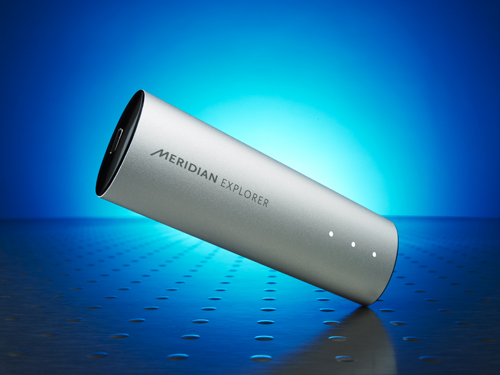What Hi-Fi? Verdict
The Explorer’s design and assured sonic performance makes it a top contender in its niche market – it’s a great product
Pros
- +
Clear and refined sound
- +
Subtle detail and precise timing
- +
Engaging performance
- +
Elegant and portable design
- +
Plays 192kHz files natively
Cons
- -
Up against some really capable rivals that are cheaper
Why you can trust What Hi-Fi?
Meet the hi-fi world’s new ‘it’ kit: the portable USB DAC, designed to improve the sound of the music coming from your PC or laptop.
We’ve had digital-to-analogue converters with USB connections for a few years now, but nowhere near the size and convenience of this new breed that’s gaining popularity.
Embracing this expanding market is the Meridian Explorer USB DAC – a small and portable DAC and headphone amplifier that simply plugs into your laptop’s USB port and transforms it into an instant hi-fi system.
It’s a simple and elegant solution, and one that’s becoming a fast-growing trend.
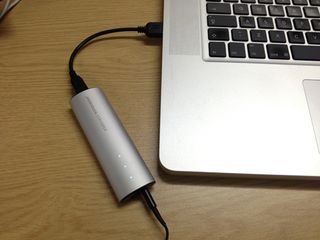
The Audioquest DragonFly kicked things off last year with its attention-grabbing design. It tucks a digital-to-analogue converter and a headphone amplifier into a device no bigger than a USB stick.
It looks fantastic, is dead easy to use, and transforms your laptop-based music collection into proper hi-fi. We hailed it as ‘hi-fi’s newest superstar’ in our October issue, and a 2012 Product of the Year Award was duly handed out.
The HRT microStreamer quickly followed suit, gaining a glowing five-star review in our March issue for its superb sonic strengths and convenience. And now British hi-fi company Meridian Audio has upped the stakes with its £250 Explorer USB DAC.
We’re used to seeing the Cambridgeshire-based company occupy the more high-end side of the hi-fi market. Meridian Audio is, after all, hi-fi royalty, being the first British manufacturer of CD players way back in 1983.
So we’re accustomed to seeing one or two more zeroes in its prices. The Meridian 808v5 Signature Reference CD Player 808.5, for example, costs a mighty £11,000.
The Explorer DAC, then – at £249 – marks a Meridian foray into the affordable end of the market, taking the competition straight to the DragonFly’s £215 and even the microStreamer’s £180 price tags.
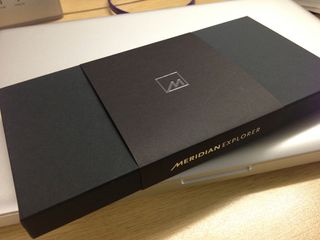
Meridian Explorer DAC: Design & Specs
The Explorer comes neatly packed in an impressive, slender black box (above). We like the sense of occasion this gives – great to feel when you’re spending £250 on a USB DAC.
In the box there’s a user guide, a short mini USB-to-USB cable to connect the DAC to your laptop, and a soft carrying pouch (with two compartments) to keep the Explorer scratch- and smudge-free.
The Meridian Explorer ticks all the right boxes for its portable design. The device looks elegant, and the slim aluminium casing feels nicely finished. It’s slightly longer than both the microStreamer and the DragonFly, but it’s still small and light enough to fit in your hand or be carried in your pocket or bag.
Meridian has used high-quality components inside the DAC, taking design cues from its higher-end 800 Reference Series to ensure the Explorer sounds its best.
Meridian Explorer DAC: Connections
Connections are housed at either end of the cylinder, and are fitted with black plastic end caps. On one side there’s the mini USB input (shown below). The DAC is an asynchronous USB design, which means that the Explorer, rather than the internal clock DAC of your computer, is in charge of controlling the timing of the data transfer.
This is far preferable, as the timing circuits inside the Explorer are of a much higher quality than those used in computers – which means there are fewer digital timing errors (jitter), leading to a better sound.
There are two USB master clocks inside to reduce jitter levels, one for 44.1, 88.2 and 176.4kHz sampling frequencies, and the other for 48, 96 and 192kHz. More accurate timing means greater clarity, precision and overall better sound performance.
Furthermore, the Explorer employs USB audio class 2.0, which allows full native playback of high-resolution 192kHz sample rates. This is opposed to audio class 1.0 –as is found in the HRT microStreamer, for example – which limits the sample rate to 96kHz, with higher sample rates having to be downsampled.
At the other end of the Explorer, you’ll find a 3.5mm headphone output that we imagine will be the most popular option when the unit is used as a portable headphone/laptop solution. This second output doubles up as both an analogue and a digital optical output.
The analogue option allows you to take a line level out to a stereo amplifier, while you can use the digital optical output (limited to 96kHz) for additional signal processing or for recording with minimal jitter.
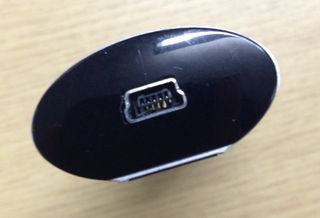
Meridian Explorer DAC: In use
Using the Meridian Explorer is easy and convenient. Mac users can just plug and play, while Windows users will have to install a driver to use the DAC.
The driver can be downloaded from the Explorer page on the Meridian website (www.meridian-audio.com). Operating software requirements for Mac users are Snow Leopard or later, while Windows XP, 7 or 8 are required for PC.
We like the short cable system for connecting up the DAC to the computer. As with the HRT microStreamer, the cable connection allows the DAC to hang comfortably next to the laptop.
The built-in USB connecter of the DragonFly is an attractive and neater solution, but the Meridian/HRT alternative is more practical and cautious for every day use. It ensures that you can move your laptop around without worrying about knocking the DAC out of the port or damaging it.
There are no markings on the Explorer’s fascia save for the Meridian logo and three light indicators: the first dot lights up to signify the DAC is connected and playing files of 44.1 or 48kHz sample rates; two lights indicates 88.2 and 96kHz sample rates are playing; all three dots lit up means the DAC is playing 176.4 or full-fat 192kHz files.
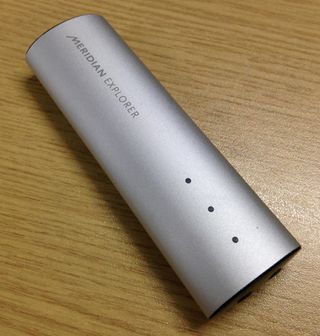
It looks elegant, though it would have been helpful to have separate indicators for all six sample rates, as employed by the microStreamer – or even DragonFly’s flashier colour change feature.
Before you get playing, make sure you’ve delved into your computer’s audio settings to select the Meridian Explorer DAC as the audio output. Once that’s done, you’re good to go. Simply open up iTunes, Spotify or even BBCiPlayer, and start playing.
There are no volume buttons or dials on the DAC itself: the Explorer piggybacks the computer’s volume controls when listening via the headphone output. As a result, all playback controls are right at your fingertips, making for a smooth listening experience.
Meridian Explorer DAC: Sound quality
And the Explorer certainly delivers a smooth and captivating performance. Compared with using the headphone output on a MacBook Pro, for instance, the Explorer provides a remarkable boost to the sound quality.
Stream Sad February by The Unthanks over Spotify, and the delicate music is full of rich textures that convey the haunting quality of the song. The piano notes clunk and glide along with the right amount of weight, and the accompanying string instruments work together in an open and well-placed soundfield.
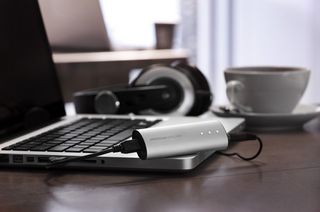
The Explorer produces a clear and clean sound with a well-judged balance: basslines are substantial and tautly controlled, while the higher frequencies have enough space to soar without any hint of brightness.
Switch to higher-quality recordings, such as a 24bit/192kHz of The Unthanks’ Blue Bleezing Blind Drunk and there’s a clear increase in the level of detail and clarity. The subtleties of Rachel Unthank’s vocals are beautifully etched out, which lets you connect emotionally with the song.
Change gears to a WAV recording of Elephants by Them Crooked Vultures, and the Meridian shows off its timing talents by reproducing the fast rhythms with energy and confidence. Notes start and stop with precision, leading to a sound that’s expressive and interesting to listen to.
How does it stand up to its rivals? The Explorer’s refined and even-balanced approach is a much more rounded performance compared with the more hard-edged sound of the DragonFly, and it shares the melodic and subtle talents of the HRT microStreamer.
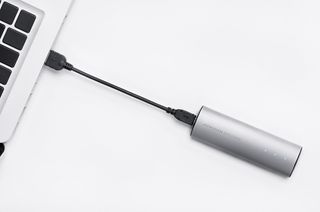
The HRT microStreamer has the edge in delivering a more transparent and insightful sound – as well as more agile and exciting timing – but we think some listeners will appreciate the Explorer’s smoother approach, which is easier on the ears for long hours of listening.
Meridian Explorer DAC: Verdict
With its elegant finish, ease of use and impressive sound quality, it’s easy to see why anyone would fall for the Explorer’s charms.
Meridian has made its mark in this portable USB DAC market, and it more than holds its own against current rivals. We’d highly recommend giving the Explorer an audition – it’s absolutely worth it.
MORE: Meridian Director DAC
What Hi-Fi?, founded in 1976, is the world's leading independent guide to buying and owning hi-fi and home entertainment products. Our comprehensive tests help you buy the very best for your money, with our advice sections giving you step-by-step information on how to get even more from your music and movies. Everything is tested by our dedicated team of in-house reviewers in our custom-built test rooms in London, Reading and Bath. Our coveted five-star rating and Awards are recognised all over the world as the ultimate seal of approval, so you can buy with absolute confidence.
